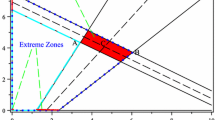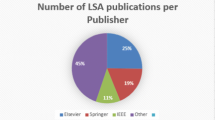Abstract
This article considers the bilevel linear programming problem with interval coefficients in both objective functions. We propose a cutting plane method to solve such a problem. In order to obtain the best and worst optimal solutions, two types of cutting plane methods are developed based on the fact that the best and worst optimal solutions of this kind of problem occur at extreme points of its constraint region. The main idea of the proposed methods is to solve a sequence of linear programming problems with cutting planes that are successively introduced until the best and worst optimal solutions are found. Finally, we extend the two algorithms proposed to compute the best and worst optimal solutions of the general bilevel linear programming problem with interval coefficients in the objective functions as well as in the constraints.




Similar content being viewed by others
References
Abass, S. A. (2010). An interval number programming approach for bilevel linear programming problem. International Journal of Management Science and Engineering Management, 5(6), 461–464.
Allahdadi, M., & Nehi, H. M. (2013). The optimal solution set of the interval linear programming problems. Optimization Letters, 7(8), 1893–1911.
Audet, C., Haddad, J., & Savard, G. (2007). Disjunctive cuts for continuous linear bilevel programming. Optimization Letters, 1(3), 259–267.
Bard, J. F. (1998). Practical bilevel optimization: algorithms and applications. Dordrecht: Kluwer Academic Publishers.
Ben-Ayed, O., & Blair, C. E. (1990). Computational difficulty of bilevel linear programming. Operations Research, 38(3), 556–560.
Bhurjee, A., & Panda, G. (2012). Efficient solution of interval optimization problem. Mathematical Methods of Operations Research, 76(3), 273–288.
Calvete, H. I., & Galé, C. (2008). Bilevel multiplicative problems: A penalty approach to optimality and a cutting plane based algorithm. Journal of Computational and Applied Mathematics, 218(2), 259–269.
Calvete, H. I., & Galé, C. (2012). Linear bilevel programming with interval coefficients. Journal of Computational and Applied Mathematics, 236(15), 3751–3762.
Chinneck, J. W., & Ramadan, K. (2002). Linear programming with interval coefficient. Journal of the Operational Research Society, 51(2), 209–220.
Christiansen, S., Patriksson, M., & Wynter, L. (1999). Stochastic bilevel programming in structural optimization. Structural and Multidisciplinary Optimization, 21(5), 361–371.
Clegg, J., Smith, M., Xiang, Y., & Yarrow, R. (2001). Bilevel programming applied to optimising urban transportation. Transportation Research Part B: Methodological, 35(1), 41–70.
Colson, B., Marcotte, P., & Savard, G. (2007). An overview of bilevel programming. Annals of Operations Research, 153(1), 235–256.
Dempe, S. (2002). Foundations of bilevel programming. Dordrecht: Kluwer Academic Publishers.
Dempe, S. (2003). Annotated bibliography on bilevel programming and mathematical programs with equilibrium constraints. Optimization, 52(3), 333–359.
Hamidi, F., & Mishmast, N. (2013). Bilevel linear programming with fuzzy parameters. Iranian Journal of Fuzzy Systems, 10(4), 83–99.
Hladík, M. (2009). Optimal value range in interval linear programming. Fuzzy Optimization and Decision Making, 8(3), 283–294.
Hladík, M. (2010). Generalized linear fractional programming under interval uncertainty. European Journal of Operational Research, 205(1), 42–46.
Hladík, M. (2011). Optimal value bounds in nonlinear programming with interval data. Top, 19(1), 93–106.
Hladík, M. (2012). Interval linear programming: A survey. In Z. A. Mann (Ed.), Linear programming-new frontiers in theory and applications, chap. 2 (pp. 85–120). New York: Nova Science Publishers.
Hladík, M. (2013). Weak and strong solvability of interval linear systems of equations and inequalities. Linear Algebra and its Applications, 438(11), 4156–4165.
Horst, R., & Tuy, H. (1996). Global optimization: deterministic approaches. Berlin: Springer.
Huang, G. H., & Moore, R. D. (1993). Grey linear programming, its solving approach, and its application. International Journal of Systems Science, 24(1), 159–172.
Karmakar, S., & Bhunia, A. K. (2013). Uncertain constrained optimization by intervaloriented algorithm. Journal of the Operational Research Society, 65(1), 73–87. doi:10.1057/jors.2012.151.
Li, W., & Tian, X. (2011). Fault detection in discrete dynamic systems with uncertainty based on interval optimization. Mathematical Modelling and Analysis, 16(4), 549–557.
Machost, B. (1970). Numerische Behandlung des Simplexverfahrens mit intervallanalytischen Methoden. Gesellschaft für Mathematik und Datenverarbeitung, Bonn.
Marcotte, P., Shiquan, W., & Chen, Y. (1993). A cutting-plane algorithm for the linear bilevel programming problem. CRT Report-925.
Rohn, J. (2006). Interval linear programming. In M. Fiedler, et al. (Eds.), Linear optimization problems with inexact data, chap. 3 (pp. 79–100). New York: Springer.
Saraj, M., & Safaei, N. (2012). Solving bi-level programming problems on using global criterion method with an interval approach. Applied Mathematical Sciences, 6, 1135–1141.
Tong, S. (1994). Interval number and fuzzy number linear programming. Fuzzy Sets and Systems, 66(3), 301–306.
Tuy, H. (1964). Concave programming under linear constraints. Soviet Mathematics, 5, 1437–1440.
Wang, J. Z., & Du, G. (2011). Research on the method for interval linear bi-level programming based on a partial order on intervals. In 2011 Eighth international conference on fuzzy systems and knowledge discovery (pp. 682–686).
White, D. J., & Anandalingam, G. (1993). A penalty function approach for solving bilevel linear programs. Journal of Global Optimizaton, 3(4), 397–419.
Wu, S., Chen, Y., & Marcotte, P. (1998). A cutting-plane method for linear bilevel programs. System Science and Mathematical Sciences, 11(2), 125–133.
Yang, H., Zhang, X., & Meng, Q. (2007). Stackelberg games and multiple equilibrium behaviors on networks. Transportation Research Part B: Methodological, 41(8), 841–861.
Zhang, G. Q., & Lu, J. (2010). Fuzzy bilevel programming with multiple objectives and cooperative multiple followers. Journal of Global Optimization, 47(3), 403–419.
Acknowledgments
This work was supported by National Natural Science Foundation of China (No. 61272119, No. 61203372) and Fundamental Research Funds for the Central Universities (K5051303009).
Author information
Authors and Affiliations
Corresponding author
Rights and permissions
About this article
Cite this article
Ren, A., Wang, Y. A cutting plane method for bilevel linear programming with interval coefficients. Ann Oper Res 223, 355–378 (2014). https://doi.org/10.1007/s10479-014-1624-4
Published:
Issue Date:
DOI: https://doi.org/10.1007/s10479-014-1624-4




